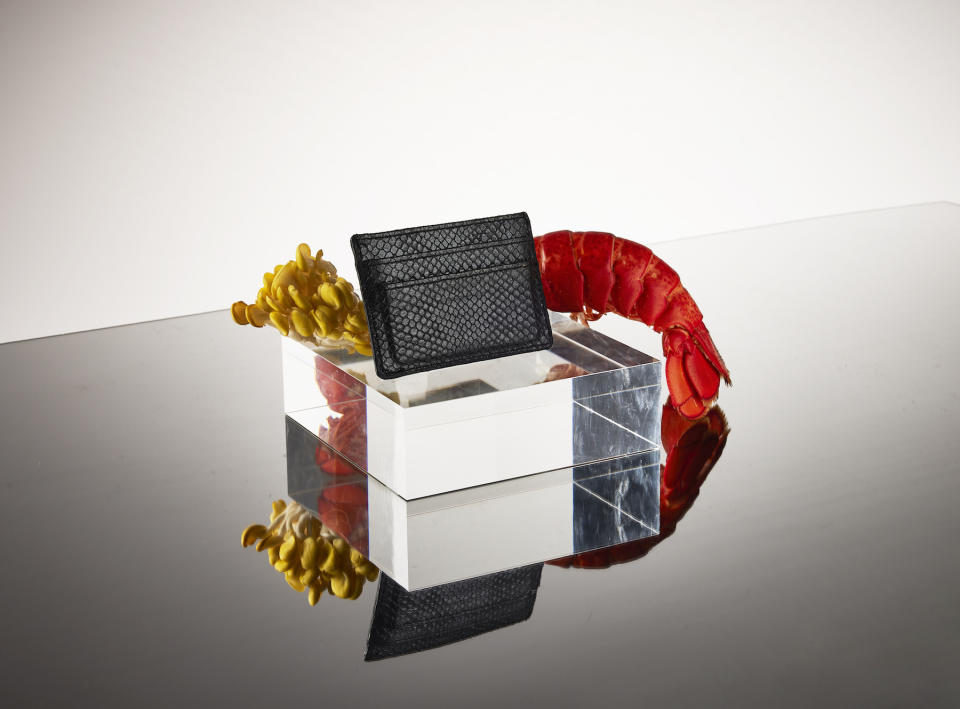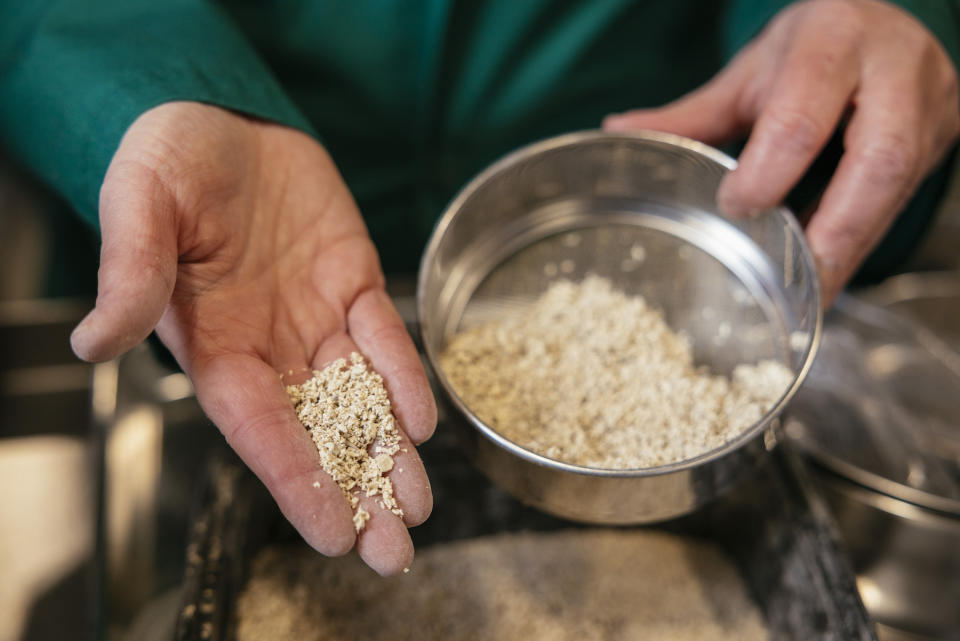Material World: Bloom Labs Wants to Make ‘Circularity an Actuality’

Material World is a weekly roundup of innovations and ideas within the materials sector, covering news from emerging biomaterials and alternative leathers to sustainable substitutes and future-proof fibers.
TômTex
While lionfish is emerging as an alternative to leather, another sea creature is contributing to sustainable and regenerative substitutions.
More from Sourcing Journal
Established in 2020 by founder Uyen Tran, TômTex uses seashells and mushrooms to offer cruelty-free and naturally biodegradable textiles that can mimic fabrics like leather, suede, latex, vinyl and more. The bio-based material from a company whose name mashes up the Vietnamese word for “shrimp” with “textile” is petrochemical-free, plastic-free and tanning-free.
“In Vietnam, we have a lot of agricultural waste and it’s one of the top countries exporting seafood, just behind China and Ecuador. So we have 450 metric tons of seashell waste that’s wasted every year and we don’t know what to do about it,” Tran said. “So, I was back in Vietnam last November where we travelled to a lot of farms who said, ‘We have nowhere to take our waste. Can we do something about it?’ So that’s how it started.”

The Brooklyn-based company’s textile is made from the complex sugar, chitin, found in shrimp shells. This chitin is converted to its most well-known derivative, chitosan, the second most abundant polymer found in nature. Chitosan is also found in the cell walls of mushrooms, which TômTex also utilizes.
“The makeup of our material is more than 80 percent…chitosan, which we can get from seashell waste or entirely from mushrooms. The [remaining] 20 percent is green chemistry—no plastic, just our ‘secret sauce’ to combine it together, but no petroleum, it’s just like organic acid,” Tran said. “A lot of the chemistry in the world is rooted in oil chemistry, and that’s sort of very limited in terms of like, innovation. We see that the way moving forward within the whole industry is to leverage what we can learn from nature and apply that to our material.”
Tran, who moved to San Francisco 10 years ago to study fashion design before relocating to New York City, is all too familiar with the waste generated by the textile industry. Growing up in Vietnam, she recalled that whatever color the river in her backyard was, that would be the next It-girl color dominating U.S. fashion trends. But her fashion education focused on teaching people to “get the resources, design something, and discard it right away,” she said. Those interested in sustainability found it was too pricey, inaccessible, or unattainable until growing consumer sentiment around eco-friendly alternatives inspired Tran to act.
But even some material innovators dabble in greenwashing, according to the founder. “A lot of other [leather] alternatives out there are blending with toxic chemicals and plastic and they say they’re sustainable,” Tran said.
TômTex emphasizes a circular business model, responsibly and transparently sourcing all its ingredients from places like Vietnam, Alaska and Canada. It uses water-based green chemistry on a 100 percent biodegradable fabric using a manufacturing process that allows it to take any form or mold and emboss into any pattern.
TômTex declined to name any brand partners, but Tran said they’re sustainability leaders known for experimenting with emerging leather alternatives. Tran did work with designer and International Woolmark Prize finalist Peter Do on his spring/summer 2023 collection at New York Fashion Week and Di Petsa for London Fashion Week in fall/winter 2023.
Mycocycle

Mycocycle recently announced $2.2 million in seed funding, bringing its lifetime raise to $3.7 million. The biotechnology company licenses a process to minimize waste, create new materials and reduce greenhouse gases using mushrooms. It harnesses the power of nature to mitigate risk for governments, manufacturers and waste operators by removing harmful toxins from trash—in less time and at equal cost—creating a renewable resource of bio-based materials for the future.
“I like to say we train mushrooms to eat trash and create renewable bio-based materials because that’s what we do every day,” Joanne Rodriguez, founder and CEO, said. “The natural ecosystem for fungi are heavy hydrocarbons. They’re the best remediator of any known organism in the world to break down heavy hydrocarbons—that’s why they’re so effective in the [construction] space.”
The process works by applying lab-cultivated fungi to shredded waste materials. That waste is “myceliated” on-site at manufacturers, recyclers and waste management companies. The resulting biomaterial can be rendered into new products for commercial or industrial use.
“We’re not a sexy technology. We’re not coming out with a new mycelium leather. We’re not replacing foams into Adidas shoes,” Rodriguez said. “We’re replacing chemicals that are mined from the Earth that go into everything, so it’s hard to picture what that end product is.”
While Mycocycle’s primary industry is construction, the company is creating a filler material with applications for the textile industry.
“The chemistry between the two [industries] is very similar,” Rodriguez said. He made a comparison between apparel and buildings. “Think about the water repellents in our clothing—that’s the same water repellent that’s in our building.” Operating in “silos of excellence” is a good place to start, he said, but “there’s a lot of value” in cross-sector collaboration that turns a waste stream from one sector into a value input for another.
If a textile company wants to use its mycelium material as a down installation alternative, Rodriguez will supply it. The goal is for Mycocycle to eventually sign up fashion brand partners.
Bloom Labs

Bloom Labs, a platform that functions as a hub for the next generation of climate-focused solutions derived from nature, has developed next-gen alternatives to natural and synthetic fibers as well as plastics.
Co-founded by third-generation textile entrepreneur and CEO Simardev S. Gultai, Bloom Labs is harnessing the value of natural waste by-products, a protein-rich and globally abundant raw material, to create new, high-performance clothing and plastic materials that are scalable and commercially viable but avoid the use of petrochemicals and resource-intensive processes.
“Our mission is to make circularity an actuality,” Gulati said. “We see a future where old resource intensive processes are replaced with cutting-edge sustainable alternatives.”
The New York-based company uses bio-manufacturing, advanced protein engineering and molecular biology for its proprietary technology that plasticizes waste, regenerating it into practical and versatile pellets. Those pellets are then spun into fibers designed to emulate the properties of common fashion materials—as soft as cotton and functional as polyester, for example. These easily transportable “plug and play” pellets can be integrated into a manufacturer’s production processes. They come without the feedstock risks or environmental impact of petroleum as well.
While 8.5 percent of global fibers produced in 2021 originated from recycled materials—primarily recycled polyester from PET bottles—less than 1 percent of fibers were produced by recycling existing textiles, the company said, stating that circularity and material innovation are key to breaking fashion’s dependence on fossil fuel and mitigating the impacts of linear economic systems.
“I stand on the shoulders of giants,” Gulati said. “Our expert team of interdisciplinary scientists, which includes the inventor of plasticized protein, Walter Schmidt, PhD, are reimagining material sourcing for multiple sectors, and developing commercially feasible alternatives which will create a future of seamless integration, infinite feedstock and limitless possibilities.”

